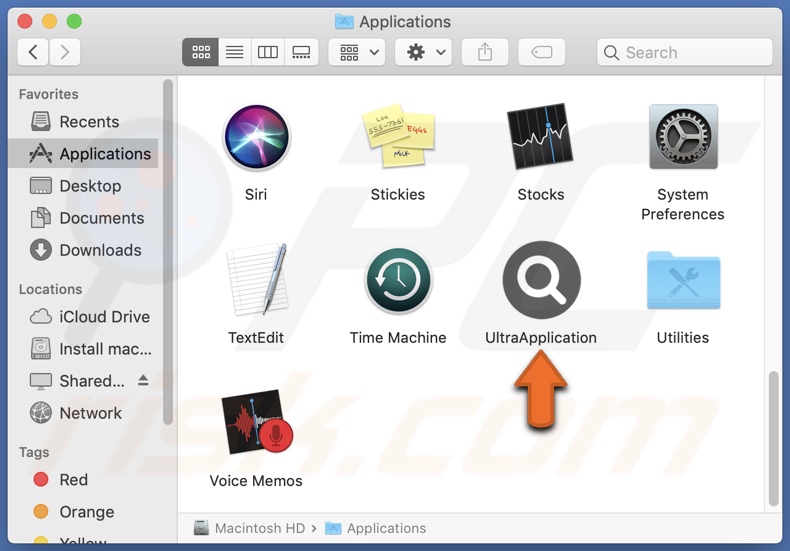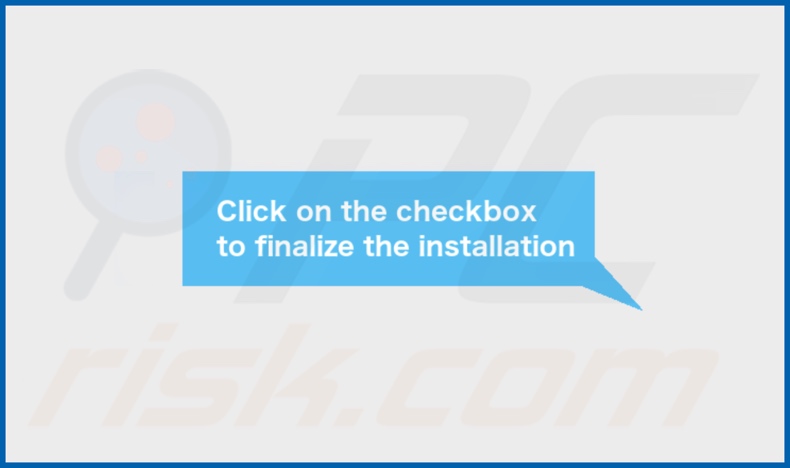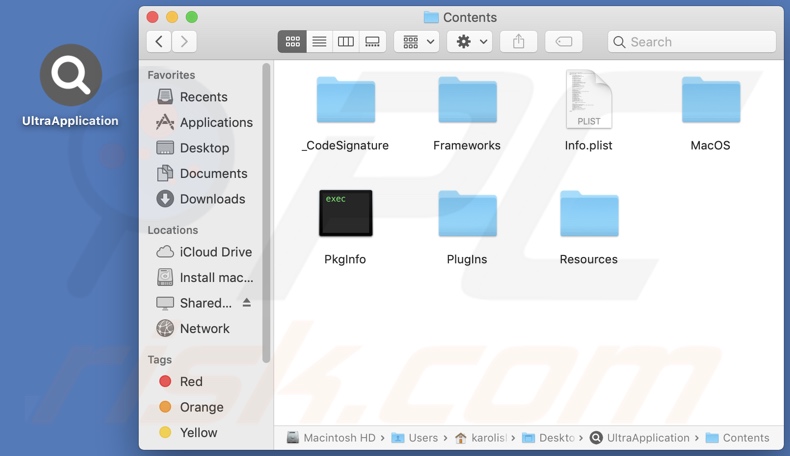Removal instructions for the UltraApplication adware-type app
Mac VirusAlso Known As: Ads by UltraApplication
Get free scan and check if your device is infected.
Remove it nowTo use full-featured product, you have to purchase a license for Combo Cleaner. Seven days free trial available. Combo Cleaner is owned and operated by RCS LT, the parent company of PCRisk.com.
What kind of application is UltraApplication?
While inspecting new file submissions to the VirusTotal platform, our researchers discovered UltraApplication. This piece of software is adware from the AdLoad malware family. The app is designed to run intrusive advertisement campaigns.

UltraApplication adware overview
Adware stands for advertising-supported software. It operates by displaying third-party graphical content (e.g., pop-ups, coupons, surveys, overlays, etc.) on visited websites and/or other interfaces.
These advertisements primarily endorse online scams, untrustworthy/hazardous software, and even malware. When clicked on, some of the ads can execute scripts to perform downloads/installations without user consent.
It is noteworthy that while genuine content may be encountered through these adverts – it is unlikely to be promoted by its actual developers or other official parties. It is most probable that this promotion is motivated by acquiring illegitimate commissions through the abuse of the endorsed product's affiliate programs.
Adware might need specific conditions to deliver intrusive advert campaigns (e.g., compatible browser/system or user geolocation, visits to particular sites, etc.). Regardless of whether UltraApplication displays advertisements – it remains a threat to device and user safety.
We have found many AdLoad applications with browser-hijacking abilities – however, UltraApplication did not exhibit these traits during our analysis.
This adware-type app likely has data-tracking functionalities, as they are standard for advertising-supported software. Targeted information may include: visited URLs, viewed pages, searched queries, Internet cookies, account log-in credentials, personally identifiable details, credit card numbers, etc. The collected data can be monetized via sale to third-parties.
In summary, the presence of software like UltraApplication on devices may result in system infections, serious privacy issues, financial losses, and even identity theft.
| Name | Ads by UltraApplication |
| Threat Type | Adware, Mac malware, Mac virus |
| Detection Names | Avast (MacOS:AdAgent-L [Adw]), Combo Cleaner (Gen:Variant.Adware.MAC.AdLoad.8), ESET-NOD32 (A Variant Of OSX/Adware.Synataeb.C), Kaspersky (Not-a-virus:HEUR:AdWare.OSX.Adload.h), Full List (VirusTotal) |
| Additional Information | This application belongs to Adload malware family. |
| Symptoms | Your Mac becomes slower than normal, you see unwanted pop-up ads, you are redirected to dubious websites. |
| Distribution methods | Deceptive pop-up ads, free software installers (bundling), torrent file downloads. |
| Damage | Internet browser tracking (potential privacy issues), display of unwanted ads, redirects to dubious websites, loss of private information. |
| Malware Removal (Windows) |
To eliminate possible malware infections, scan your computer with legitimate antivirus software. Our security researchers recommend using Combo Cleaner. Download Combo CleanerTo use full-featured product, you have to purchase a license for Combo Cleaner. 7 days free trial available. Combo Cleaner is owned and operated by RCS LT, the parent company of PCRisk.com. |
Adware examples
We have investigated countless adware-type apps; ReferCyberspace, ProductCommand, TaskParameter, IndexerArchive, EssentialFrequency – are just some examples.
Advertising-supported software typically appears ordinary and innocuous. Users may be enticed into downloading/installing adware by promises of various handy functionalities. However, these functions seldom work as promised, and in most cases – they are completely nonoperational.
Keep in mind that even if a piece of software works exactly as indicated by its promotional material – that does not prove its legitimacy or safety.
How did UltraApplication install on my computer?
Adware is endorsed on legitimate-looking promotional pages and scam sites. Most users access these webpages via redirects generated by intrusive ads, websites employing rogue advertising networks, misspelled URLs, spam browser notifications, or installed adware (with browser force-opening capabilities).
Advertising-supported software can also be bundled with regular programs. The threat of unintentionally allowing bundled content into the device is increased by downloading from untrustworthy channels (e.g., freeware and third-party sites, Peer-to-Peer sharing networks, etc.) and by treating installations with negligence (e.g., ignoring terms, using "Easy/Express" settings, etc.).
Intrusive advertisements proliferate adware as well. Some of these adverts can be triggered (i.e., by being clicked) to execute scripts that perform downloads/installations without user permission.
How to avoid installation of adware?
We highly recommend researching software before downloading or purchasing it. Additionally, all downloads must be made from official and verified sources. Installation processes must be treated with caution, e.g., by reading terms, exploring available options, using the "Custom/Advanced" settings, and opting out of all supplementary apps, extensions, features, etc.
Fraudulent and malicious online content usually appears legitimate and harmless – therefore, we strongly advise being vigilant while browsing. For example, while intrusive ads may look innocuous – they redirect to unreliable and questionable websites (e.g., gambling, scam-promoting, pornography, adult dating, etc.).
If you keep encountering adverts/redirects of this kind, check the device and immediately remove all suspicious applications and browser extensions/plug-ins. If your computer is already infected with UltraApplication, we recommend running a scan with Combo Cleaner Antivirus for Windows to automatically eliminate this adware.
Pop-up window displayed once UltraApplication adware's installation is over:

UltraApplication adware's installation folder:

Instant automatic malware removal:
Manual threat removal might be a lengthy and complicated process that requires advanced IT skills. Combo Cleaner is a professional automatic malware removal tool that is recommended to get rid of malware. Download it by clicking the button below:
DOWNLOAD Combo CleanerBy downloading any software listed on this website you agree to our Privacy Policy and Terms of Use. To use full-featured product, you have to purchase a license for Combo Cleaner. 7 days free trial available. Combo Cleaner is owned and operated by RCS LT, the parent company of PCRisk.com.
Quick menu:
- What is UltraApplication?
- STEP 1. Remove UltraApplication related files and folders from OSX.
- STEP 2. Remove UltraApplication ads from Safari.
- STEP 3. Remove UltraApplication adware from Google Chrome.
- STEP 4. Remove UltraApplication ads from Mozilla Firefox.
Video showing how to remove UltraApplication adware using Combo Cleaner:
UltraApplication adware removal:
Remove UltraApplication-related potentially unwanted applications from your "Applications" folder:

Click the Finder icon. In the Finder window, select "Applications". In the applications folder, look for "MPlayerX","NicePlayer", or other suspicious applications and drag them to the Trash.
After removing the potentially unwanted application(s) that cause online ads, scan your Mac for any remaining unwanted components.
DOWNLOAD remover for malware infections
Combo Cleaner checks if your computer is infected with malware. To use full-featured product, you have to purchase a license for Combo Cleaner. 7 days free trial available. Combo Cleaner is owned and operated by RCS LT, the parent company of PCRisk.com.
Remove adware-related files and folders

Click the Finder icon, from the menu bar. Choose Go, and click Go to Folder...
 Check for adware generated files in the /Library/LaunchAgents/ folder:
Check for adware generated files in the /Library/LaunchAgents/ folder:

In the Go to Folder... bar, type: /Library/LaunchAgents/

In the "LaunchAgents" folder, look for any recently-added suspicious files and move them to the Trash. Examples of files generated by adware - "installmac.AppRemoval.plist", "myppes.download.plist", "mykotlerino.ltvbit.plist", "kuklorest.update.plist", etc. Adware commonly installs several files with the exact same string.
 Check for adware generated files in the ~/Library/Application Support/ folder:
Check for adware generated files in the ~/Library/Application Support/ folder:

In the Go to Folder... bar, type: ~/Library/Application Support/

In the "Application Support" folder, look for any recently-added suspicious folders. For example, "MplayerX" or "NicePlayer", and move these folders to the Trash.
 Check for adware generated files in the ~/Library/LaunchAgents/ folder:
Check for adware generated files in the ~/Library/LaunchAgents/ folder:

In the Go to Folder... bar, type: ~/Library/LaunchAgents/

In the "LaunchAgents" folder, look for any recently-added suspicious files and move them to the Trash. Examples of files generated by adware - "installmac.AppRemoval.plist", "myppes.download.plist", "mykotlerino.ltvbit.plist", "kuklorest.update.plist", etc. Adware commonly installs several files with the exact same string.
 Check for adware generated files in the /Library/LaunchDaemons/ folder:
Check for adware generated files in the /Library/LaunchDaemons/ folder:

In the "Go to Folder..." bar, type: /Library/LaunchDaemons/

In the "LaunchDaemons" folder, look for recently-added suspicious files. For example "com.aoudad.net-preferences.plist", "com.myppes.net-preferences.plist", "com.kuklorest.net-preferences.plist", "com.avickUpd.plist", etc., and move them to the Trash.
 Scan your Mac with Combo Cleaner:
Scan your Mac with Combo Cleaner:
If you have followed all the steps correctly, your Mac should be clean of infections. To ensure your system is not infected, run a scan with Combo Cleaner Antivirus. Download it HERE. After downloading the file, double click combocleaner.dmg installer. In the opened window, drag and drop the Combo Cleaner icon on top of the Applications icon. Now open your launchpad and click on the Combo Cleaner icon. Wait until Combo Cleaner updates its virus definition database and click the "Start Combo Scan" button.

Combo Cleaner will scan your Mac for malware infections. If the antivirus scan displays "no threats found" - this means that you can continue with the removal guide; otherwise, it's recommended to remove any found infections before continuing.

After removing files and folders generated by the adware, continue to remove rogue extensions from your Internet browsers.
Remove malicious extensions from Internet browsers
 Remove malicious Safari extensions:
Remove malicious Safari extensions:

Open the Safari browser, from the menu bar, select "Safari" and click "Preferences...".

In the preferences window, select "Extensions" and look for any recently-installed suspicious extensions. When located, click the "Uninstall" button next to it/them. Note that you can safely uninstall all extensions from your Safari browser - none are crucial for regular browser operation.
- If you continue to have problems with browser redirects and unwanted advertisements - Reset Safari.
 Remove malicious extensions from Google Chrome:
Remove malicious extensions from Google Chrome:

Click the Chrome menu icon ![]() (at the top right corner of Google Chrome), select "More Tools" and click "Extensions". Locate all recently-installed suspicious extensions, select these entries and click "Remove".
(at the top right corner of Google Chrome), select "More Tools" and click "Extensions". Locate all recently-installed suspicious extensions, select these entries and click "Remove".

- If you continue to have problems with browser redirects and unwanted advertisements - Reset Google Chrome.
 Remove malicious extensions from Mozilla Firefox:
Remove malicious extensions from Mozilla Firefox:

Click the Firefox menu ![]() (at the top right corner of the main window) and select "Add-ons and themes". Click "Extensions", in the opened window locate all recently-installed suspicious extensions, click on the three dots and then click "Remove".
(at the top right corner of the main window) and select "Add-ons and themes". Click "Extensions", in the opened window locate all recently-installed suspicious extensions, click on the three dots and then click "Remove".

- If you continue to have problems with browser redirects and unwanted advertisements - Reset Mozilla Firefox.
Frequently Asked Questions (FAQ)
What harm can adware cause?
Adware-displayed advertisements can promote content capable of causing severe issues (e.g., system infections, financial losses, etc.). This software can decrease browsing quality and assistant performance. Adware is also considered to be a privacy threat, as it usually gathers sensitive information.
What does adware do?
Adware stands for advertising-supported software. It enables the placement of third-party graphical content (adverts) on visited websites and/or different interfaces. Additionally, adware may be capable of force-opening webpages and collecting private data.
How do adware developers generate revenue?
Adware developers generate revenue through content promotion (e.g., websites, apps, extensions, products, services, etc.). Most of the profit is made through affiliate programs.
Will Combo Cleaner remove UltraApplication adware?
Yes, Combo Cleaner will scan your device and eliminate installed adware-type applications. Keep in mind that manual removal (performed without security tools) might not be an ideal solution. In some instances, after the adware has been manually removed – various components (files) remain hidden within the system. These remnants might continue to run and cause problems. Therefore, advertising-supported software must be removed thoroughly.
Share:

Tomas Meskauskas
Expert security researcher, professional malware analyst
I am passionate about computer security and technology. I have an experience of over 10 years working in various companies related to computer technical issue solving and Internet security. I have been working as an author and editor for pcrisk.com since 2010. Follow me on Twitter and LinkedIn to stay informed about the latest online security threats.
PCrisk security portal is brought by a company RCS LT.
Joined forces of security researchers help educate computer users about the latest online security threats. More information about the company RCS LT.
Our malware removal guides are free. However, if you want to support us you can send us a donation.
DonatePCrisk security portal is brought by a company RCS LT.
Joined forces of security researchers help educate computer users about the latest online security threats. More information about the company RCS LT.
Our malware removal guides are free. However, if you want to support us you can send us a donation.
Donate
▼ Show Discussion